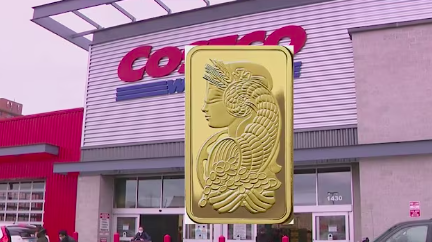Shock as Costco limits THIS unexpected item—is your favorite product next?
- Replies 0
Gold bars may not be on your usual Costco shopping list—but maybe they should be.
From $1.50 hot dogs to bulk toilet paper, Costco is known for value, not precious metals.
But in a surprising twist, the wholesale giant has quietly placed strict new limits on gold bar purchases, and the move has triggered a flurry of speculation.
What’s behind the sudden change—and could it signal bigger shifts in the economy?
Costco first dipped its toes into the gold market in 2023, offering one-ounce gold bars for about $1,950 each. What started as a novelty quickly became a buying frenzy.
Within minutes of restocking—online or in-store—the bars vanished.
Fast forward to 2024, and Costco is selling up to $200 million worth of gold bars each month, according to recent estimates. With gold prices recently soaring past $3,400 an ounce, it’s no surprise the buzz has only intensified.
And now, Costco is capping the craze.
Under the new policy, customers can only buy one gold bar every 24 hours—a sharp reduction from previous limits, which allowed two two-ounce bars per purchase or even five 100-gram bars per transaction just last year.
This limit isn’t just about inventory—it’s about managing demand and preserving fairness.
As buyers rush to stockpile physical gold amid inflation fears and tariff talks, Costco is trying to ensure its glitzy investment option doesn’t vanish before more members get a chance.
Also read: This Costco find made one shopper $600 in no time
Gold has always been the go-to “safe haven” in times of economic uncertainty, and right now, there’s plenty to worry about:
According to deal trackers and social media users, Costco keeps its markup slim—often between 0.8% and 2.4% over spot price. That’s lower than many traditional gold dealers, making it a cost-effective entry point for novice investors and savvy shoppers alike.
Also read: That label said "fresh"—but what a Costco shopper found tells a different story
Still, prices have climbed. Bars that sold for under $2,000 in 2023 are now going for over $2,300 and rising. And with predictions that gold could hit $4,000 per ounce by 2026, many shoppers still see plenty of room for growth.
Experts say Costco’s gold bar sales could top $2.4 billion a year if demand holds. And with tariff reductions from China now in play, the precious metals market could remain volatile—and highly lucrative.
Whether you see gold as a solid investment or just a shiny distraction, one thing is clear: Costco’s vault isn’t infinite, and you’ll need speed, strategy, and maybe a bit of luck to grab a bar before they’re gone.
Read next: A new bakery favorite is drawing crowds at Costco—Don’t miss out!

Have you tried to snag a gold bar at Costco? Did you score one, or miss out in the blink of an eye? Do you see gold as a smart hedge—or just financial FOMO? Share your thoughts in the comments below.
From $1.50 hot dogs to bulk toilet paper, Costco is known for value, not precious metals.
But in a surprising twist, the wholesale giant has quietly placed strict new limits on gold bar purchases, and the move has triggered a flurry of speculation.
What’s behind the sudden change—and could it signal bigger shifts in the economy?
Costco first dipped its toes into the gold market in 2023, offering one-ounce gold bars for about $1,950 each. What started as a novelty quickly became a buying frenzy.
Within minutes of restocking—online or in-store—the bars vanished.
Fast forward to 2024, and Costco is selling up to $200 million worth of gold bars each month, according to recent estimates. With gold prices recently soaring past $3,400 an ounce, it’s no surprise the buzz has only intensified.
And now, Costco is capping the craze.
Under the new policy, customers can only buy one gold bar every 24 hours—a sharp reduction from previous limits, which allowed two two-ounce bars per purchase or even five 100-gram bars per transaction just last year.
This limit isn’t just about inventory—it’s about managing demand and preserving fairness.
As buyers rush to stockpile physical gold amid inflation fears and tariff talks, Costco is trying to ensure its glitzy investment option doesn’t vanish before more members get a chance.
Also read: This Costco find made one shopper $600 in no time
Gold has always been the go-to “safe haven” in times of economic uncertainty, and right now, there’s plenty to worry about:
- Inflation and high interest rates
- Ongoing global trade tensions
- Concerns over market instability and tariff hikes
According to deal trackers and social media users, Costco keeps its markup slim—often between 0.8% and 2.4% over spot price. That’s lower than many traditional gold dealers, making it a cost-effective entry point for novice investors and savvy shoppers alike.
Also read: That label said "fresh"—but what a Costco shopper found tells a different story
Still, prices have climbed. Bars that sold for under $2,000 in 2023 are now going for over $2,300 and rising. And with predictions that gold could hit $4,000 per ounce by 2026, many shoppers still see plenty of room for growth.
Experts say Costco’s gold bar sales could top $2.4 billion a year if demand holds. And with tariff reductions from China now in play, the precious metals market could remain volatile—and highly lucrative.
Whether you see gold as a solid investment or just a shiny distraction, one thing is clear: Costco’s vault isn’t infinite, and you’ll need speed, strategy, and maybe a bit of luck to grab a bar before they’re gone.
Read next: A new bakery favorite is drawing crowds at Costco—Don’t miss out!
Key Takeaways
- Costco is now limiting customers to one gold bar purchase per 24 hours, down from higher previous limits, due to surging demand.
- Gold prices have topped $3,400 per ounce, pushing Costco’s monthly gold sales to $200 million, with projections of up to $2.4 billion annually.
- Costco’s competitive pricing (0.8–2.4% markup over spot price) and economic instability have fueled a modern-day gold rush.
- Despite the hype, platinum bars haven't matched gold's popularity and may decline further if global trade tensions escalate.







